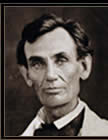by Claude N. Frechette, M.D.
Conclusion
The substantial number of identical characteristics of the young man of the Kaplan daguerreotype and those of Abraham Lincoln include,
- Identical horizontal and vertical facial bone structure;
- Identical soft tissue landmarks including the appearance and
implantation of the hair, the height of the forehead, the robust nose,
the well marked philtral columns of the upper lip, the pouting lower
lip, and the shape of the ear with its free-hanging, detached lobe;
- Identical congenital anomalies including his rare bilateral ptosis,
and prominent ears;
- Identical acquired facial sequellae of his childhood head trauma including exophoria of the left eye. Dr. Kempf described Lincoln's other trauma-induced facial deformities: "The right side of the chin is larger than the left ....", and "The left half of the upper lip is somewhat thicker than the right ....", and "His cheek bones were unusually high and prominent. The right was larger than the left, and the right orbital ridge and lower jaw were more heavily developed than the left, giving the whole face a decided morphological curve toward the right. This deformation becomes distinctly visible when the full face photographs are turned upside down."
Accordingly, I conclude that the Abraham Lincoln of the early 1840s is, without the possibility of misidentification, the very man of the Kaplan daguerreotype.

